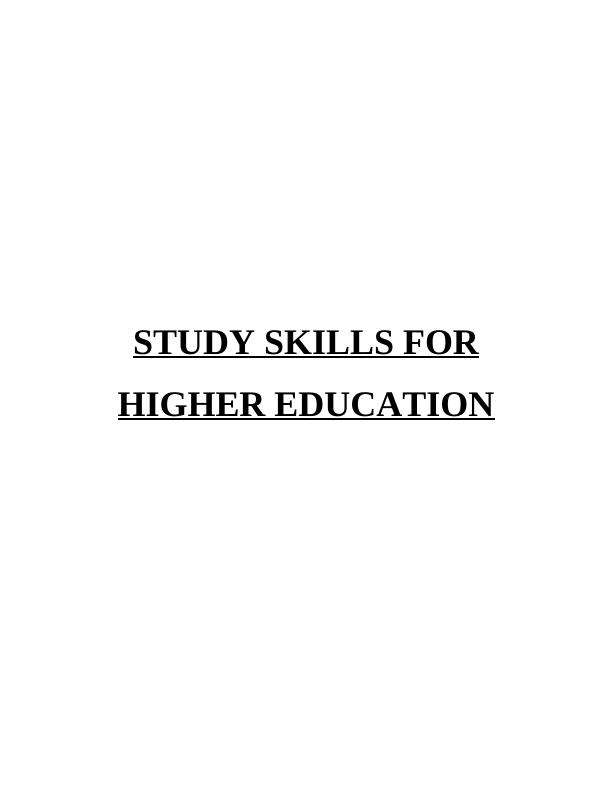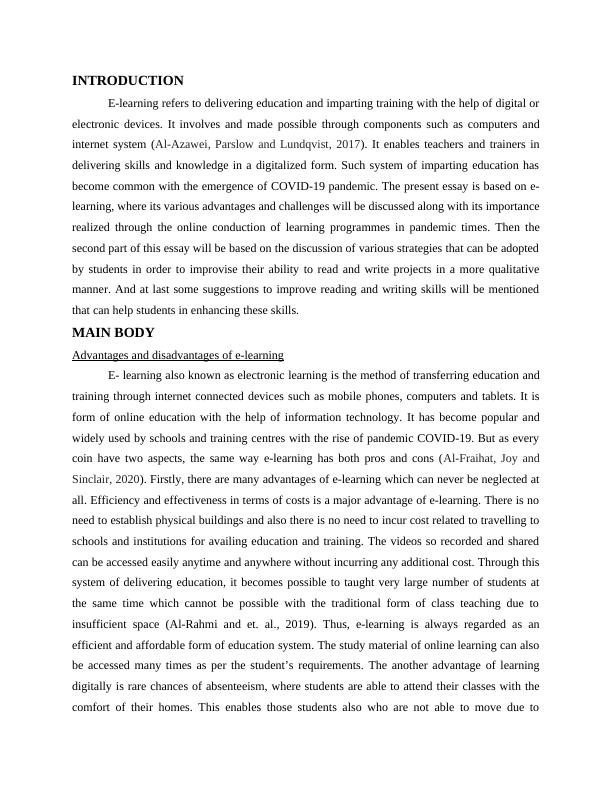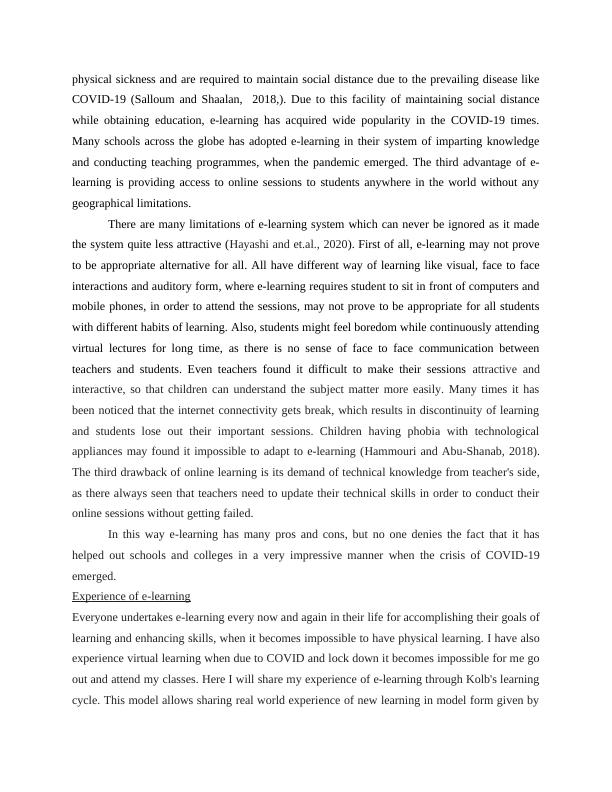Study Skills for Higher Education
Added on 2022-12-28
12 Pages3894 Words47 Views
STUDY SKILLS FOR
HIGHER EDUCATION
HIGHER EDUCATION

Table of Contents
INTRODUCTION...........................................................................................................................3
MAIN BODY...................................................................................................................................3
Advantages and disadvantages of e-learning...............................................................................3
Experience of e-learning..............................................................................................................4
Strategies towards improving reading ability..............................................................................5
Strategies for improving writing quality of projects....................................................................8
Conclusion:....................................................................................................................................10
REFERENCES................................................................................................................................1
INTRODUCTION...........................................................................................................................3
MAIN BODY...................................................................................................................................3
Advantages and disadvantages of e-learning...............................................................................3
Experience of e-learning..............................................................................................................4
Strategies towards improving reading ability..............................................................................5
Strategies for improving writing quality of projects....................................................................8
Conclusion:....................................................................................................................................10
REFERENCES................................................................................................................................1

INTRODUCTION
E-learning refers to delivering education and imparting training with the help of digital or
electronic devices. It involves and made possible through components such as computers and
internet system (Al-Azawei, Parslow and Lundqvist, 2017). It enables teachers and trainers in
delivering skills and knowledge in a digitalized form. Such system of imparting education has
become common with the emergence of COVID-19 pandemic. The present essay is based on e-
learning, where its various advantages and challenges will be discussed along with its importance
realized through the online conduction of learning programmes in pandemic times. Then the
second part of this essay will be based on the discussion of various strategies that can be adopted
by students in order to improvise their ability to read and write projects in a more qualitative
manner. And at last some suggestions to improve reading and writing skills will be mentioned
that can help students in enhancing these skills.
MAIN BODY
Advantages and disadvantages of e-learning
E- learning also known as electronic learning is the method of transferring education and
training through internet connected devices such as mobile phones, computers and tablets. It is
form of online education with the help of information technology. It has become popular and
widely used by schools and training centres with the rise of pandemic COVID-19. But as every
coin have two aspects, the same way e-learning has both pros and cons (Al-Fraihat, Joy and
Sinclair, 2020). Firstly, there are many advantages of e-learning which can never be neglected at
all. Efficiency and effectiveness in terms of costs is a major advantage of e-learning. There is no
need to establish physical buildings and also there is no need to incur cost related to travelling to
schools and institutions for availing education and training. The videos so recorded and shared
can be accessed easily anytime and anywhere without incurring any additional cost. Through this
system of delivering education, it becomes possible to taught very large number of students at
the same time which cannot be possible with the traditional form of class teaching due to
insufficient space (Al-Rahmi and et. al., 2019). Thus, e-learning is always regarded as an
efficient and affordable form of education system. The study material of online learning can also
be accessed many times as per the student’s requirements. The another advantage of learning
digitally is rare chances of absenteeism, where students are able to attend their classes with the
comfort of their homes. This enables those students also who are not able to move due to
E-learning refers to delivering education and imparting training with the help of digital or
electronic devices. It involves and made possible through components such as computers and
internet system (Al-Azawei, Parslow and Lundqvist, 2017). It enables teachers and trainers in
delivering skills and knowledge in a digitalized form. Such system of imparting education has
become common with the emergence of COVID-19 pandemic. The present essay is based on e-
learning, where its various advantages and challenges will be discussed along with its importance
realized through the online conduction of learning programmes in pandemic times. Then the
second part of this essay will be based on the discussion of various strategies that can be adopted
by students in order to improvise their ability to read and write projects in a more qualitative
manner. And at last some suggestions to improve reading and writing skills will be mentioned
that can help students in enhancing these skills.
MAIN BODY
Advantages and disadvantages of e-learning
E- learning also known as electronic learning is the method of transferring education and
training through internet connected devices such as mobile phones, computers and tablets. It is
form of online education with the help of information technology. It has become popular and
widely used by schools and training centres with the rise of pandemic COVID-19. But as every
coin have two aspects, the same way e-learning has both pros and cons (Al-Fraihat, Joy and
Sinclair, 2020). Firstly, there are many advantages of e-learning which can never be neglected at
all. Efficiency and effectiveness in terms of costs is a major advantage of e-learning. There is no
need to establish physical buildings and also there is no need to incur cost related to travelling to
schools and institutions for availing education and training. The videos so recorded and shared
can be accessed easily anytime and anywhere without incurring any additional cost. Through this
system of delivering education, it becomes possible to taught very large number of students at
the same time which cannot be possible with the traditional form of class teaching due to
insufficient space (Al-Rahmi and et. al., 2019). Thus, e-learning is always regarded as an
efficient and affordable form of education system. The study material of online learning can also
be accessed many times as per the student’s requirements. The another advantage of learning
digitally is rare chances of absenteeism, where students are able to attend their classes with the
comfort of their homes. This enables those students also who are not able to move due to

physical sickness and are required to maintain social distance due to the prevailing disease like
COVID-19 (Salloum and Shaalan, 2018,). Due to this facility of maintaining social distance
while obtaining education, e-learning has acquired wide popularity in the COVID-19 times.
Many schools across the globe has adopted e-learning in their system of imparting knowledge
and conducting teaching programmes, when the pandemic emerged. The third advantage of e-
learning is providing access to online sessions to students anywhere in the world without any
geographical limitations.
There are many limitations of e-learning system which can never be ignored as it made
the system quite less attractive (Hayashi and et.al., 2020). First of all, e-learning may not prove
to be appropriate alternative for all. All have different way of learning like visual, face to face
interactions and auditory form, where e-learning requires student to sit in front of computers and
mobile phones, in order to attend the sessions, may not prove to be appropriate for all students
with different habits of learning. Also, students might feel boredom while continuously attending
virtual lectures for long time, as there is no sense of face to face communication between
teachers and students. Even teachers found it difficult to make their sessions attractive and
interactive, so that children can understand the subject matter more easily. Many times it has
been noticed that the internet connectivity gets break, which results in discontinuity of learning
and students lose out their important sessions. Children having phobia with technological
appliances may found it impossible to adapt to e-learning (Hammouri and Abu-Shanab, 2018).
The third drawback of online learning is its demand of technical knowledge from teacher's side,
as there always seen that teachers need to update their technical skills in order to conduct their
online sessions without getting failed.
In this way e-learning has many pros and cons, but no one denies the fact that it has
helped out schools and colleges in a very impressive manner when the crisis of COVID-19
emerged.
Experience of e-learning
Everyone undertakes e-learning every now and again in their life for accomplishing their goals of
learning and enhancing skills, when it becomes impossible to have physical learning. I have also
experience virtual learning when due to COVID and lock down it becomes impossible for me go
out and attend my classes. Here I will share my experience of e-learning through Kolb's learning
cycle. This model allows sharing real world experience of new learning in model form given by
COVID-19 (Salloum and Shaalan, 2018,). Due to this facility of maintaining social distance
while obtaining education, e-learning has acquired wide popularity in the COVID-19 times.
Many schools across the globe has adopted e-learning in their system of imparting knowledge
and conducting teaching programmes, when the pandemic emerged. The third advantage of e-
learning is providing access to online sessions to students anywhere in the world without any
geographical limitations.
There are many limitations of e-learning system which can never be ignored as it made
the system quite less attractive (Hayashi and et.al., 2020). First of all, e-learning may not prove
to be appropriate alternative for all. All have different way of learning like visual, face to face
interactions and auditory form, where e-learning requires student to sit in front of computers and
mobile phones, in order to attend the sessions, may not prove to be appropriate for all students
with different habits of learning. Also, students might feel boredom while continuously attending
virtual lectures for long time, as there is no sense of face to face communication between
teachers and students. Even teachers found it difficult to make their sessions attractive and
interactive, so that children can understand the subject matter more easily. Many times it has
been noticed that the internet connectivity gets break, which results in discontinuity of learning
and students lose out their important sessions. Children having phobia with technological
appliances may found it impossible to adapt to e-learning (Hammouri and Abu-Shanab, 2018).
The third drawback of online learning is its demand of technical knowledge from teacher's side,
as there always seen that teachers need to update their technical skills in order to conduct their
online sessions without getting failed.
In this way e-learning has many pros and cons, but no one denies the fact that it has
helped out schools and colleges in a very impressive manner when the crisis of COVID-19
emerged.
Experience of e-learning
Everyone undertakes e-learning every now and again in their life for accomplishing their goals of
learning and enhancing skills, when it becomes impossible to have physical learning. I have also
experience virtual learning when due to COVID and lock down it becomes impossible for me go
out and attend my classes. Here I will share my experience of e-learning through Kolb's learning
cycle. This model allows sharing real world experience of new learning in model form given by

End of preview
Want to access all the pages? Upload your documents or become a member.
Related Documents
Advantages and Disadvantages of Online Learning in the COVID-19 Pandemiclg...
|11
|3775
|352
Academic Study Skills: Advantages and Disadvantages of Online Learninglg...
|11
|3542
|479
Advantages and Disadvantages of E-Learninglg...
|7
|2019
|1
Advantages and Disadvantages of Online Learning during COVID-19lg...
|11
|3792
|193
e-Learning in Nursing Educationlg...
|10
|2180
|111
Pros and Cons of Online Learning - Basic Statistics and ICT skillslg...
|8
|515
|475
